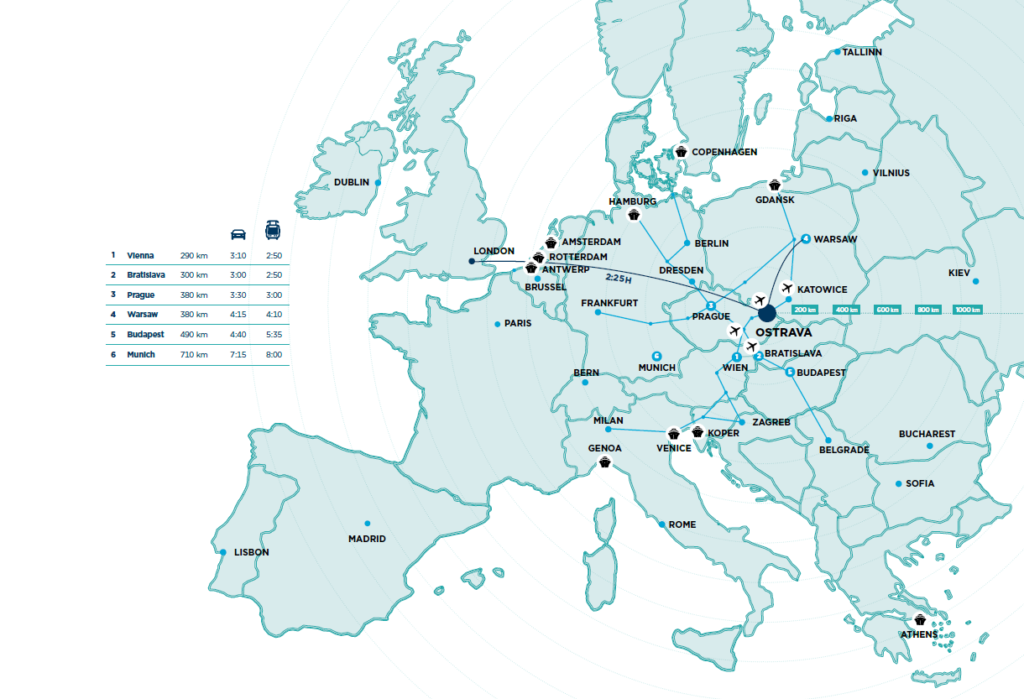A key element in the city’s development strategy is its long-term close cooperation with investors. In recent years, Ostrava has become a highly attractive base for numerous international companies keen to exploit the potential offered by the city’s strategic location, which gives excellent access to the Czech, Polish and Slovak markets. Add to that Ostrava’s modern infrastructure, a highly qualified workforce and systematic support for R&D, and it is clear that the city holds strong potential for dynamic growth.
- The capital of the Moravian-Silesian Region – the industrial, administrative, commercial and university centre of the Czech Republic’s most populous region (1.2 million people).
- A strategic location close to the borders with Poland and Slovakia, with excellent transport links including Ostrava’s international airport (OSR).
- 4 universities, bilingual schools and schools with an international focus – a well-educated, highly qualified and flexible workforce.
- An excellent business environment – Ostrava and its region are home to numerous major international investors.
- Strong infrastructure for business support, with a focus on R&D and innovation.
- A high quality of life – a vibrant cultural and sporting life, with excellent civic amenities in a safe and livable city.
- A high credit rating – Ostrava has been rated Aa3/stable by Moody’s.



POPULATION
Ostrava – the second largest Czech city in area, the third largest in population – actively targets potential international investors and has gained a reputation as an attractive business destination, not only within the Czech Republic but throughout the Central European region. With 276 000 people living in Ostrava itself, the city is the capital and administrative centre of the Moravian-Silesian Region, which has a population of over 1.2 million. Around 10 million people live within a 120-km radius of Ostrava.
LOCATION
Ostrava has a strategic geographical location in the north-east of the Czech Republic, situated on one of Europe’s main international transport corridors connecting the Baltic Sea and the Adriatic Sea. The city is located around 5 hours by car from the Baltic, and 8 hours from the Adriatic. Excellent access to the Polish and Slovak markets means that Ostrava is a major economic, commercial and cultural hub for the wider region.
TRANSPORT INFRASTRUCTURE
Ostrava has a sophisticated network of transportation infrastructure (an international airport, international highways and rail corridors, and an excellent integrated regional public transport system). It continues to grow in importance as a railway hub for both passenger and freight transport, with direct access to an international airport that connects the region with the wider world. Leoš Janáček Ostrava Airport (OSR) offers scheduled and charter flights as well as air cargo services. Lucrative sites adjacent to the airport are available to develop – click this link for more details. The combination of air and rail transport for both passengers and cargo is unique in the Czech Republic, giving this location a clear competitive advantage.
Ostrava’s airport currently serves scheduled flights to/from London and Málaga with Ryanair. In March 2022 LOT Polish Airlines launched regular shuttle services between Ostrava and Warsaw, giving easy access to a further 100+ destinations in Europe, North America and Asia. Cargo is an important part of operations at Ostrava’s airport, which serves two of the world’s largest logistics providers: there are regular flights to Leipzig (DHL) and Cologne (UPS). Regular cargo connections with China were launched in 2019, and in February 2021 this service was expanded to include flights for general cargo. A new hangar was opened in 2020, providing direct access to a railway siding; this ensures that Ostrava’s air cargo services can be expanded in the future. Other international airports within 1 to 1½ hours of Ostrava are in Poland – Kraków and Katowice.



HUMAN RESOURCES
One of Ostrava’s biggest advantages for business is the city’s strong human resources potential, with highly qualified graduates of specialist vocational colleges and universities (especially technical studies).

The city is home to three universities: the VŠB Technical University, the University of Ostrava and the private PRIGO University College. There is also a private Business School and other higher vocational colleges. The city has a number of bilingual primary/secondary schools or schools with a strong international focus, such as the 1st International School of Ostrava, the Ostrava International School, the PRIGO International School and the PORG School. Ostrava also offers schools with an alternative approach, including the Montessori School and the Waldorf School.



INVESTMENT
For many years Ostrava has taken a strongly pro-investment approach – for example, 36% of the city’s 2024 budget is devoted to investment projects. This year, the city is operating with a record budget (nearly 14.8 billion CZK).
In 1997, the city established the Ostrava Science and Technology Park in the Pustkovec district. Covering around 10 hectares, the park is the Moravian-Silesian Region’s largest physical infrastructure complex for science and technology research and innovation; located right next to Ostrava’s VŠB Technical University, it has close connections with the academic sphere. Currently the park offers almost 11 000 m2 of office space, labs and workshops, and it is managed by the Moravian-Silesian Innovation Centre (MSIC) under the name T-Park. Besides the four existing multifunctional buildings (I – Piano, II – Tandem, III – Trident, and IV – Viva), which house the T-Park’s technical and administrative facilities, other development sites are now available for high-added-value activities based on the knowledge economy. The T-Park is set for expansion, with a new building planned (T6, total floor area 24 000 m2). The city is currently in discussions with the developer CTP Invest on the sale of the land.
A milestone for investment in Ostrava came with the completion of the D1 international highway, which linked Ostrava with other Central European regions and helped attract a huge volume of foreign direct investment.
One of the most important investments came in 2007, when the South Korean carmaker Hyundai Motor Company began production at the industrial zone in Nošovice. The zone became a major auto industry hub, with a number of Korean suppliers setting up operations there.
Ostrava is also a base for other globally renowned companies such as PEGATRON Czech, Tietoevry, SungWoo Hitech, CTP Invest, Mahle Behr, Siemens, Contera and many more.
An important consideration for investors in the region is Ostrava’s excellent credit rating from Moody’s. The city’s rating continues to rise, and it has now reached Aa3/stable – one of the best performances from any city in Central Europe.
RESEARCH, DEVELOPMENT AND INNOVATION
Ostrava is becoming a hub for research, development and innovation – activities which will shape the future of the city and the entire region. A network of research institutions, universities and innovation centres creates a highly dynamic environment for industries focused on new technologies and their practical applications. Thanks to the strong synergy between the Moravian-Silesian Innovation Centre (MSIC), the local universities and partners from industry, Ostrava is becoming a leader in advanced technologies – a trajectory that creates unique opportunities for investment.
The Moravian-Silesian Innovation Centre (MSIC), the Business Innovation Centre Ostrava, the Centre for Advanced and Innovative Technologies, the Business Incubator and other organizations offer not only assistance when integrating new business activities, but also the opportunity to apply research results and use the facilities of Ostrava’s technical university and other educational institutions.

